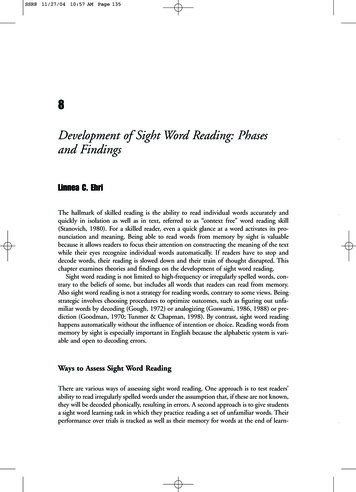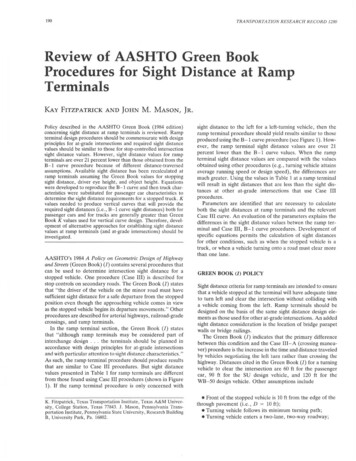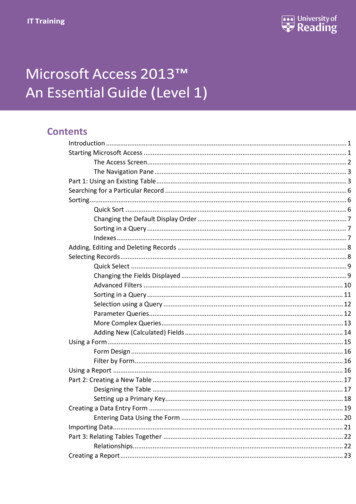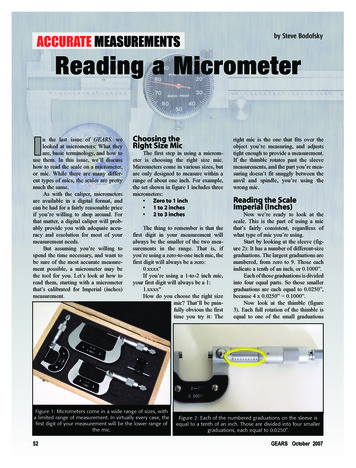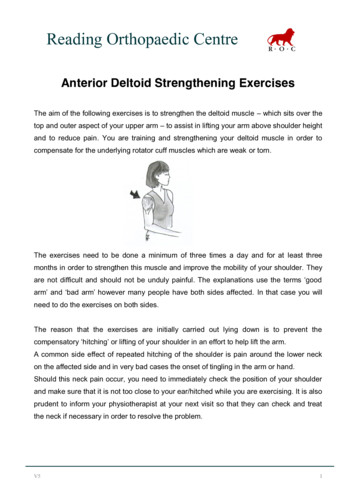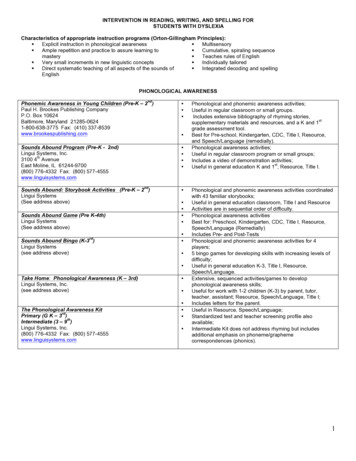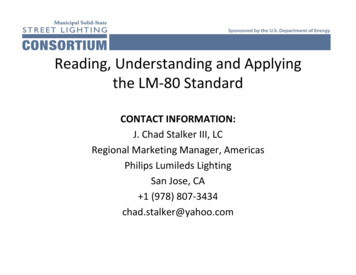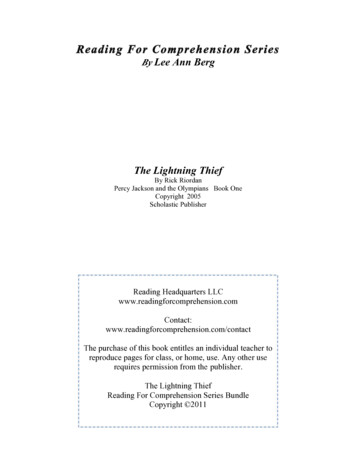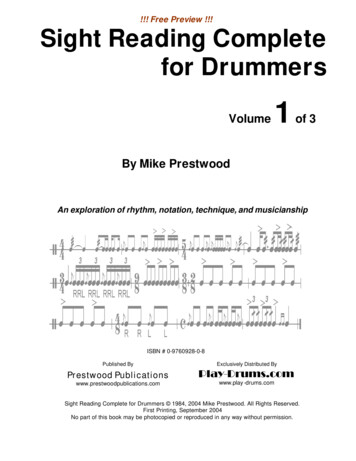
Transcription
!!! Free Preview !!!Sight Reading Completefor DrummersVolume1of 3By Mike PrestwoodAn exploration of rhythm, notation, technique, and musicianshipISBN # 0-9760928-0-8Published ByExclusively Distributed ByPrestwood s.comwww.play -drums.comSight Reading Complete for Drummers 1984, 2004 Mike Prestwood. All Rights Reserved.First Printing, September 2004No part of this book may be photocopied or reproduced in any way without permission.
DedicationI dedicate this method series to my first drum instructor Joe Santoro. Joe is abrilliant instructor and an exceptional percussionist. With his guidance, Iprogressed quickly and built a foundation for a lifetime of drumming fueled by hisencouragement and enthusiasm.Cover Design: Patrick RamosCover Photography: Michelle WalkerMusic Engraving: Mike PrestwoodSpecial thanks to: James LaRheir and Leslie Prestwood
ContentsIntroduction.1Lesson 1: Technique .7Lesson 2: Tempo and Beat Grouping .9Lesson 3: Whole, Half, Quarter .11Lesson 4: Snare and Bass .13Lesson 5: 2/4 and 3/4 Time .15Lesson 6: 8th Notes .17Lesson 7: 16th Notes.20Lesson 8: Closed Rolls.22Lesson 9: Single Stroke Roll.25Lesson 10: Dotted Notes and Rests .26Lesson 11: Repeats.28Lesson 12: 8th Rest .30Lesson 13: 16th Notes - 1e& and 1 &a .32Lesson 14: 8th Note Closed Roll.33Lesson 15: 8th Note Beat Time Signatures.34Lesson 16: 6/8, 9/8, and 12/8.36Lesson 17: Tempo Markings .38Lesson 18: Dynamics .42Lesson 19: Flams .45Lesson 20: Ruffs.46Lesson 21: Double Strokes.47Lesson 22: Alla Breve (Cut Time) .48Lesson 23: Triplets.49Appendix A: Warm-Up Set 1.50Appendix B: 8th Note Accent Patterns .52Appendix C: Snare Solos.54
IntroductionThis thorough and balanced exploration of rhythm, notation, technique, and musicianship has several purposes. You canuse this series as a complete primer to playing orchestral snare or as a precursor to playing rudimental snare, drum set,timbales, or any other percussion instrument that uses drumsticks. Advanced players and professionals can use this fastpaced exploration of their craft to fine-tune their timing and sight-reading abilities and to fill in holes in their education. Ihave tried to use a practical approach and I hope you find it valuable during your entire career.Here is what I tried to do with the lessons: Rhythm – Each lesson introduces new rhythmic elements. I tried to keep a fast pace while providing a thoroughexploration. After completing the lessons, you will be equipped to correctly interpret and understand nearly any rhythm.If you play along with the audio files available with this series, your timing will improve and, with consistent practice,you will be able to play nearly anything you want. Notation – When appropriate, the lessons include clear explanations and alternative notation styles such as the use of1-line and 5-line staffs, stems up or down, flams and ruffs with and without ties, and many other commonly occurringvariations in drum notation. Technique –This series covers most drumstick-based techniques including grip, building chops, flams, ruffs, closedroll techniques, and more. Although most of the technique information is included in “Lesson 1 – Technique”, there aregems of knowledge spread throughout. All three volumes contain an appendix A and B. In each of the three volumes,appendix A is a warm up and appendix B contains chop building exercises. Musicianship – Having the ability to sight-read is one thing, but music notation is just part of the bigger picture. Whereappropriate, this series delves into such subjects as interpretation, playing with others, dynamics, tempo, etc.While developing these lessons, I strove for a fast pace and an even amount of coverage for each topic. In addition, eachlesson is as complete as possible and is as independent from the other lessons as reasonable. This allows you to review alesson and focus on the topic of the lesson. You will find yourself returning to various lessons throughout your career toreview or re-enforce your playing abilities. Some of the lessons serve as excellent reference sources including suchlessons as repeats, dynamics, tempo markings, etc.What’s not included?The title “Sight Reading Complete for Drummers” is a lofty and daunting title. This series presents the elements ofdrumming as interpreted by me. It focuses on the elements used by non-pitched percussionists who use drumsticks. Inaddition, this series focuses on the common elements. For example, it does not include outdated notation techniques andobscure new inventions.Each percussion instrument has its own unique playing techniques. For example, percussionists can play the snare drumwith either a rudimental style or an orchestral style. They will interpret (play) the same drum part differently depending onwhich style they are playing. Percussionists play timpani, a pitched percussion instrument, using soft mallets and amodified grip and stroke. As a final example, drummers play drumset differently depending on the genre they are playing.thRock drummers typically play 8 notes straight and jazz drummers typically play 8th notes with a rolling (triplet) feel – toname just one difference. This series does not attempt to cover all playing variations. Instead, it focuses on snare drumtechniques and introduces enough of the other playing techniques to raise awareness.About Volume 1Volume 1 covers the basics of drumming -- the fundamentals. It starts with this introduction, a technique lesson, and ameter lesson. Then it follows with lessons that explore rhythm and various aspects of drumming.Getting the Most Out of this BookSince Volume 1 serves the dual purpose of first method book and review book, beginners and advanced players will getdifferent things out of it.For those just getting started in drums, read the introductory material and proceed straight through Volume 1 fromlesson 1 through lesson 23. Start each practice session with a warm up using either lesson 1 or 2 of this volume. If youthalready know 8 notes and accents, then build your chops after you warm up using Appendix B as written. Play along withthe audio files as part of your daily practice sessions. Except for lesson 1, play only to the 100 BPM files.Advanced players can skip certain lessons or parts of lessons that are obviously targeting new drummers. Start eachpractice session with a warm up either using the exercises in lesson 1 or appendix A, and build your chops using appendixB as written or using one of the variations. Strive for a very high quality musical sound. Play the audio files as part of yourdaily practice sessions focusing on the slowest and fastest audio files.Review: After completing the lessons in this method series, you can use these books for review material and chopbuilding. If you own all three volumes of this series, here is a formula for getting the most out of them:1. Warm Up - Warm up using appendix A of any one volume. The volume 1 warm up, this volume, is quick and easywhile the warm ups in volumes 2 and 3 are more complex. Strive for loose and relaxed muscles.2. Build Your Chops – Build your chops using appendix B of any one volume.3. Take a Lesson - Choose one lesson from each volume (three lessons total) and review the material.Sight Reading Complete for Drummers – free preview!1Vol. 1 -- Introduction
Practicing DrumsHow much you practice depends on your goals. If your goals include becoming a world-class drummer, practice severalhours every day. After all, world-class pianists practice piano for many hours every day. On the other end of the spectrum,if you are a student just getting started, practice at least 30 minutes every day. If you cannot practice the usual 30 minutesa day, squeeze in at least 15 minutes or even 5 minutes a day along with a one to two hour practice session at least oncea week. It is better to practice a little every day, than to practice a lot a couple of times a week. Your goal is to get in thehabit of daily or near daily practice.Advanced DrummersI developed this series with both the student and the professional in mind. (In fact, I developed it with myself in mind. Iwanted something I could use with my practice sessions.)Here is some advice: Drum Set Practicing – If you are a drum set player, play the beat count with your hi-hat foot, the bass part with yourbass foot, and the snare part on the snare. Video Tape – Set up your video camera and record yourself playing. When you watch yourself play, you will noticesubtle areas you need to work on. In addition, video taping yourself lets you see your good habits and reinforces them.Student GuideBe patient with yourself and have many years of fun with this book. You can use a practice pad or a snare drum to practiceeach exercise. However, you should practice on a snare drum as much as possible. No practice pad can replace a realdrum.Get a Drum Teacher! Unless you are an advanced student, a drum teacher is necessary if you expect to progress at arapid pace.Tempo Advice - Use a metronome wisely!If you have a metronome, use it. If you do not, buy one. For percussionists, a metronome is part of your fundamental gearand as important as your drumsticks.It is a good idea to alternate playing to a metronome and playing without one. If you always practice to a metronome, youmight develop a need to play only with a metronome. If you practice at various tempos with and without a metronome andplay along to the audio files for this series, you will develop good time. Tapping your foot is also a useful timekeeper.Practice playing while tapping your foot and not tapping your foot.Unspecified/Specified Tempos: Lesson 2 briefly introduces tempo markings and I usually specified the tempo startingfrom lesson 17 through the lessons in volume 3. Practice the exercises in this series at the specified tempo first. Thenpractice at other tempos as desired. Start each exercise at a slow comfortable tempo and work up to the specified tempoor, when not specified, use a comfortable tempo. Repeat each exercise several times. In general, repeat sight-readingexercises until you are comfortable with the rhythm and notation. Repeat technique exercises a minimum of 10 times.Sticking StylesThere are two common sticking styles: right hand lead and alternating. With the right hand lead style, you use your righthand primarily for downbeats and the left hand primarily for upbeats. With the alternating style, you alternate your stickingas you see fit. You might find right hand lead is easier to play because you play the same rhythms using the same stickingeach time. Some of the exercises in this series indicate both styles below the notes. I suggest you master both styles.Play-Drums.comYou will find supplemental information at the followinginternet address:www.play-drums.com/sightreadingThis is the official website for this series and includesfree movies that demonstrate various techniquesincluded in this series as well as related material suchas marching snare, drum set playing, and otherexercises.Download the MP3 Audio FilesIn order to perfect your timing and ability to play atvarious tempos, you need to hear the rhythms and playalong with them. Free MP3 audio files for the lessons inthis series are available for download. You can playthem on your computer, download them to your MP3player, or burn them to CD. Get the files now atwww.play-drums.com/sightreading/downloadSight Reading Complete for Drummers – free preview !Here is a guide to the file naming convention: 1-Lesson ## Ex ## ### BPM The exercise(s) atthe given tempo. This will either be snare only, or snareand bass, depending on the exercise. Bass If “Bass” is indicated, then this version is the bassdrum only part, which is helpful with learning to play alongwith other instruments. Click If “Click” is indicated, then this version is a clicktrack at the given tempo. These versions are particularlyhelpful with the time switching exercises. Check If “Check” is indicated, this version contains arhythmic check pattern. This is particularly helpful with thetiming and accent exercises.Online Message BoardPost your questions and comments on our message board.Online Teacher GuideAn online teacher’s guide is available at play-drums.com.2Vol. 1 -- Introduction
Drum Notation & ReferenceThis section introduces enough music notation theory so that you will both be able to get started playing the lessons in thisbook and have a fundamental understanding of how composers notate drums and percussion. In additi
No part of this book may be photocopied or reproduced in any way without permission. Dedication I dedicate this method series to my first drum instructor Joe Santoro. Joe is a brilliant instructor and an exceptional percussionist. With his guidance, I progressed quickly and built a foundation for a lifetime of drumming fueled by his encouragement and enthusiasm. Cover Design: Patrick Ramos .
